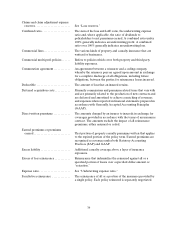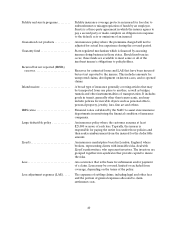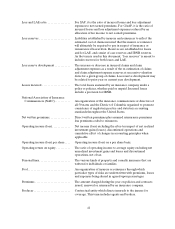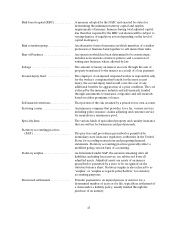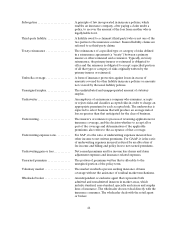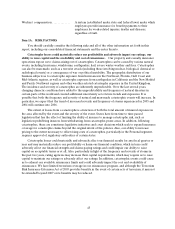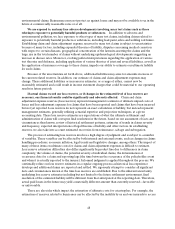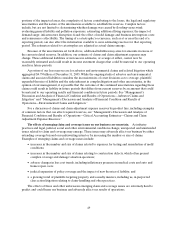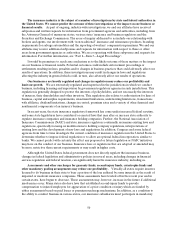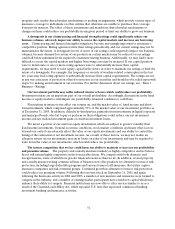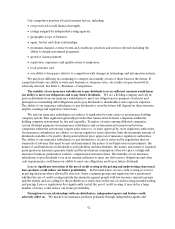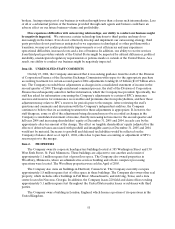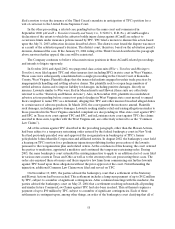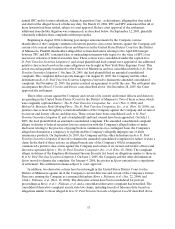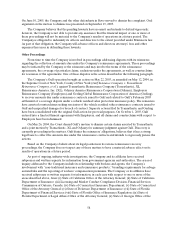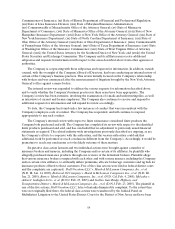Travelers 2005 Annual Report Download - page 61
Download and view the complete annual report
Please find page 61 of the 2005 Travelers annual report below. You can navigate through the pages in the report by either clicking on the pages listed below, or by using the keyword search tool below to find specific information within the annual report.49
portions of the impacted areas, the complexity of factors contributingto the losses, the legal and regulatory
uncertainties and the nature of the information available to establish the reserves. Complex factors
include, but are not limited to: determining whether damage was caused by flooding versus wind;
evaluating general liability and pollution exposures; estimating additional living expenses; the impact of
demand surge; infrastructure disruption; fraud; the effect of mold damage and business interruption costs;
and reinsurance collectibility. The timing of a catastrophe’s occurrence, such as at or near the end of a
reporting period, can also affect the information available to us inestimating reserves for that reporting
period. The estimates related to catastrophes are adjusted as actual claims emerge.
Because of the uncertainties set forth above, additional liabilities may arise for amounts in excess of
the current related reserves. In addition, our estimate of claims and claim adjustment expenses may
change. These additional liabilities or increases in estimates, or a range of either, cannot now be
reasonably estimated and could result in income statement charges that could be material to our operating
results in future periods.
A portion of our loss reserves are for asbestos and environmental claims and related litigation which
aggregated $4.79 billion at December 31, 2005. While the ongoing study of asbestos and environmental
claims and associated liabilities considers the inconsistencies of court decisions as to coverage, plaintiffs’
expanded theories of liability and the risks inherent in complex litigation and other uncertainties, in the
opinion of our management, it is possible that the outcome of the continued uncertainties regarding these
claims could result in liability in future periods that differs from current reserves by an amount that could
be material to our operating results and financial condition in future periods. See “Management’s
Discussion and Analysis of Financial Condition and Results of Operations—Asbestos Claims and
Litigation” and “Management’s Discussion and Analysis of Financial Condition and Results of
Operations—Environmental Claims and Litigation.”
For a discussion of claims and claim adjustment expense reserves by product line, including examples
of common factors that can affect required reserves, see “Management’s Discussionand Analysis of
Financial Condition and Results of Operations—Critical AccountingEstimates—Claims and Claim
Adjustment Expense Reserves.”
The effects of emerging claim and coverage issues on our business are uncertain. As industry
practices and legal, judicial, social and other environmental conditions change, unexpected and unintended
issues related to claim and coverage may emerge. These issues may adversely affect our business by either
extending coverage beyond our underwriting intent or by increasing the number or size of claims.
Examples of emerging claims and coverage issues include:
•increases in the number and size of claims related to expenses for testing and remediation of mold
conditions;
•increases in the number and size of claims relating to construction defects, which often present
complex coverage and damage valuation questions;
•adverse changes in loss cost trends, including inflationary pressures in medical costs and auto and
home repair costs;
•judicial expansion of policy coverage and the impact of new theories of liability; and
•a growing trend of plaintiffs targeting property and casualty insurers, including us, in purported
class action litigation relating to claim-handling and other practices.
The effects of these and other unforeseen emerging claim and coverage issues are extremely hard to
predict and could harm our business and adversely affect our results of operations.


